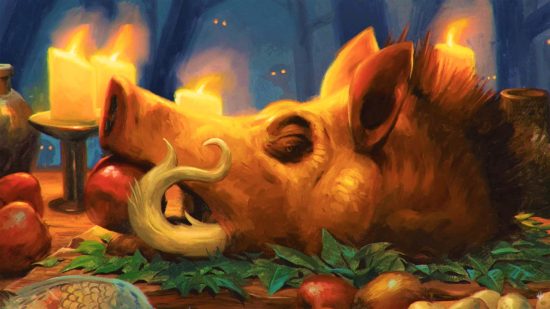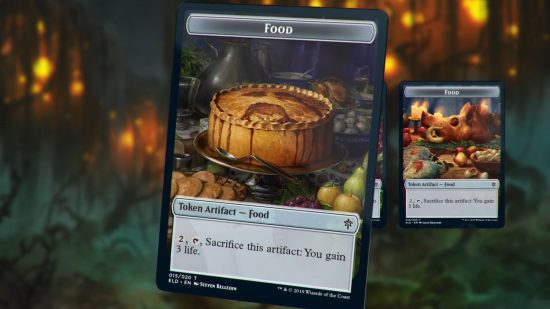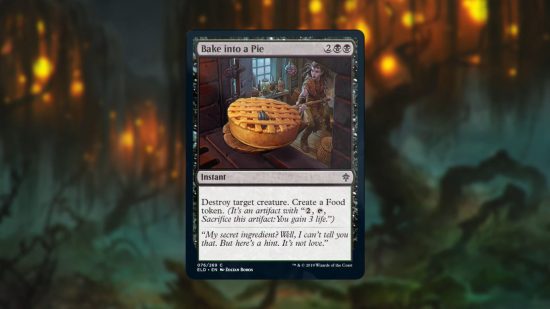MTG head designer Mark Rosewater reckons the Food mechanic is a big contender for future Magic sets. Writing for two official Magic: The Gathering blog posts on December 19 and January 3, Rosewater uses his ‘Storm Scale’ to rank mechanics from the past couple of years. Based on factors like the mechanic’s popularity, flexibility, and playability, Rosewater estimates the likelihood of their return. Food is a top tomato for 2019-2021 with a Storm Scale rank of two.
“Food tokens are so flavourful (pun intended) that they’re very easy to want to include in many sets”, Rosewater says. “We’ve made them deciduous, so I expect to see them a lot in the future.”
Food was first introduced to Magic: The Gathering in the 2019 set Throne of Eldraine, and it’s since been seen in Commander 2021, Modern Horizons 2, and Streets of New Capenna. It’s a token and artifact type that typically offers life gain in exchange for mana and the card’s sacrifice.
In his first blog post, Rosewater explains two years’ worth of Magic sets were examined for this Storm Scale ranking in particular. These are: Throne of Eldraine, Ikoria: Lair of Behemoths, Zendikar Rising, Kaldheim, and Strixhaven: School of Mages. Rosewater says he’d already ranked Theros Beyond Death, so this was left out.
Rosewater’s Storm Scale is a ranking from one to ten, with one being “will definitely see again, most likely in the next set” and ten being “ I never say never, but this would require a major miracle”. Rank two is for mechanics Rosewater says we “will definitely see again”, but it won’t necessarily be soon.
When it comes to Food, the Storm Scale highlights its design space, versatility, and playability as big selling points. “Artifact tokens are easy to design as they can be the byproduct of many different things”, Rosewater says. “Food tokens want to be as flavorful as possible (pun, as always, intended), which makes their design a little more challenging but doesn’t really cut off design space.”
“Life gain is about as universal as things come, so it’s never hard to make Food tokens matter”, he adds. Rosewater also says, other than the need to represent Food tokens, they’re pretty straightforward in playability terms.
It’s not all gravy, though; Rosewater says there are a few obstacles that stop food from becoming a regular Magic main course. “Life gain can slow down gameplay if not carefully used”, Rosewater says, “so Play Design must ensure that it’s not just about adding life to the game”. “This usually means ensuring there are other ways to make use of Food tokens, which creates difficulties for Play Design.” “The more you have in the set, the trickier it is to balance”, he adds.
Finally, there’s the fact that Food just isn’t that beloved (in Magic, that is – everyone loves a tasty meal). “Food tokens fall just below the line between the top half and the bottom half of the ratings”, Rosewater says. “Players seem to like the flavour of the token, but it’s not something players seem to adore or loathe.”
“I should note that the token cost (having to make a token that will appear in the set, and all the mind space that comes along with having a noncreature token) will make us think twice before including it”, Rosewater adds in his final summary, “so it’s not something I think will show up too frequently”.
Food also isn’t necessarily the only likely comeback from these mechanics. Snap-on equipment also scored a two on the Storm Scale in the second blog post, and it scored better than Food in terms of popularity, play design, and ease of development.
There are plenty of big sets coming up in the MTG 2023 release schedule, so perhaps Food will make an appearance in one of those. If you need something to occupy your brain while you wait to find out, we suggest some digital Magic. Here are some guides to MTG Arena codes and MTG Arena decks to get you started.


